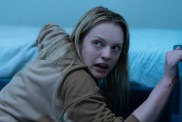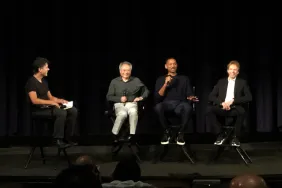
You may have read our CinemaCon coverage last week, and one of the biggest topics of conversation and discussion that we only touched upon was the advent of new technology, including laser projection and the decision by filmmakers such as Peter Jackson to start filming digitally with higher frame rates. There’s no debate on my end that higher frame rates will allow for better quality reproduction of a filmmaker’s vision and kudos to Peter Jackson for being the first to step forward and use this new technology for such a high profile movie like The Hobbit.
In brief, the current film framerate standard for the last 80 years has been 24 frames per second, so cameras are essentially capturing 24 shots each second, which is far less than what the naked eye can absorb. Since digital technology doesn’t have the same film cost limitations of shooting on analog film, cutting edge filmmakers like Peter Jackson and James Cameron wondered why digital cameras couldn’t shoot at a higher frame rate and movies couldn’t be projected at that rate. We’ve all gotten used to seeing movies and other things at the lower frame rate, so doubling it is pretty drastic even if it’s still well within the range the human eye and mind can see. Some projector companies like Barco are already proclaiming they can project up to 120 FPS which is about as lifelike as seeing something firsthand.
The idea of shooting at higher frame rates is certainly an interesting prospect but as I was sitting through an Industry Think Tank panel at CinemaCon last week, I couldn’t stop thinking, “How are we going to sell this to moviegoers?” It’s really easy to explain how 3D or IMAX adds to the filmgoing experience–3D adds depth; IMAX is bigger–but it’s a lot harder to discuss something so technical that to laymen i.e. the majority of moviegoers, it’s not so obvious what it might bring to their experience. It certainly will not be easy to convince moviegoers to pay more money to see movies at a higher frame rate, especially if part of that selling point is that it makes 3D look smoother, because too many moviegoers are already unhappy about having to pay more money to see movies in 3D.
Sure, we can say “48FPS is better” for one reason or another, but I’m not sure that everyone who watched the ten minutes of footage from The Hobbit was convinced it was indeed better. Granted, the footage shown wasn’t even remotely close to being finished and a lot more work needs to be done, but reaction to the presentation by online movie writers was muted at best, so if the “tastemakers” aren’t already fully on board with what Peter Jackson is doing, how are they going to convince moviegoers that’s the way to see the movie? This is the same problem happening with 3D where there are so many vocal advocates against 3D in any form that it’s becoming harder and harder for 3D movies to make any sort of mark, regardless of whether it’s fully shot in 3D or converted afterwards.
The big question is whether normal moviegoers–you know, the ones who just show up at the theater and look at the marquee and see what’s playing–show up and go “Wow, that movie is 48 frames per second! I gotta see that!” Most moviegoers just want a good story and a fun moviegoing experience, so how many of them really will care about 48 FPS? How do we explain something so technical to people who don’t really need to know the technical details of the movies they’re watching? Far too many moviegoers don’t even seem to care enough about the quality of their projection or sound to get up and say anything when they’re off.
Towards the end of the Industry Think Tank panel seminar, I asked the question about selling 48PS to moviegoers and IMAX President Greg Foster gave this wise and diplomatic response:
“I think the most important thing of all is that when a filmmaker of Peter Jackson’s stature says this is what they want to do, and you go ahead and the studio makes a movie, you support them. One of the interesting things about the internet, one of the interesting things about Gen Y and social media is that in fact, the filmmaker has become the star, more sometimes than the actor. As we can all tell from Peter’s moment in the presentation yesterday, he’s very passionate about it and very knowledgeable about it, and he’s designed the movie accordingly. I think that it’s our job to support the lead and design of the filmmaker in whatever way possible.”
Greg’s right, because any fan of Peter Jackson’s work will respect the filmmaker enough to want to see the movie as he intended it to be seen, and Jackson’s right in that there’s really no reason for filmmakers to still be shooting at 24 FPS if there are other options. One of the earliest issues of shooting digitally was that it was just too grainy. As that’s been improved by high-definition digital cameras, more filmmakers are going in that direction, and higher sample rates means that what’s being filmed will be captured more realistically. Considering how much time is spent by production and costume designers and set decorators to create the most realism in their sets, why wouldn’t a filmmaker want to fully capture and immerse the moviegoer into the experience of actually being there? If it also makes the 3D experience a smoother one by causing less eye strain, maybe more of those opposed to 3D will accept it.
Having come from the music business, I’ve seen this before. I’ve watched the world of music recording transition from using large tank-like analog tape machines to equally-large digital machines to using smaller and smaller computers, and once almost everyone was convinced that recording digitally was okay and the format was set at 16 bit and 48 KHz as the standard for CDs, new technology was introduced to record digitally at higher sample rates and bit formats in order to more perfectly capture the aural quality of what was being produced in the studio in order to bring it to music lovers in the same pristine quality. The debates of analog vs. digital went on for many years. Lines were drawn. Friends became enemies and then friends again. And with all of that behind the music industry, how many people download a song from iTunes thinking “Oh, this was recorded at 48 bit 96khz so it must be a great record!”? I’ll tell you how many. None.
With filmmakers potentially shooting their movies 48FPS and wanting them projected at the higher frame rate, many more questions arise like whether this will create yet another version of the movie to play in theaters so that The Hobbit will be available in 3D, 3D IMAX, 3D 48FPS, and regular old digital 2D?
Either way, theaters are going to have to change their projectors again, and while for some, it will be a simple software patch, some might need to completely replace older digital projectors. Like with digital and 3D, whenever theater owners have to shell out their own money for technical upgrades, they generally want to know they can make that money back, usually by passing on the cost to moviegoers with higher ticket prices. Maybe theaters should just do the upgrade to make their digital projectors 48FPS compatible and if a digital 3D movie shows up that was shot at 48FPS, they’ll be ready to translate the filmmaker’s vision to moviegoers in the best way possible, just like they would try to do with every movie.
Maybe the question shouldn’t be how to sell 48 FPS to moviegoers as much as whether it needs to be sold to them at all? Maybe 48FPS just needs to be a natural and integral part of the digital 3D filmgoing experience, and projector manufacturers and exhibitors will just have to bite the bullet and upgrade their projectors to be able to play the higher frame rate if they want customers to see The Hobbit in their theaters. The theaters that do the upgrade will be able to advertise both in-house and in local papers, “We have full 48FPS!” and the fans that know the difference will almost inevitably buy tickets there. Everyone else who doesn’t care about that stuff will just go see the movie wherever it’s playing nearby and with movies like The Hobbit, there should be more than enough interest that even the theaters playing it in 2D will bring in business.
I have a feeling this is going to continue to be a huge topic of conversation over the next seven months leading up to the release of the first The Hobbit movie. A lot of the onus is going to be on Warner Bros. to decide whether they really need to include the 48FPS factor in their advertising or just let the fans and moviegoers learn about it the same way they learn about any other aspect of film technology, through websites like CS and others.
Realizing that few of those reading this will have seen anything in 48FPS, but may have read or heard some stuff about it, what do you think about Peter Jackson’s groundbreaking decision? If you were already planning on seeing The Hobbit will you feel the need to only see it in 3D at 48FPS? Or do you just want to see the movie in the most convenient way possible?









